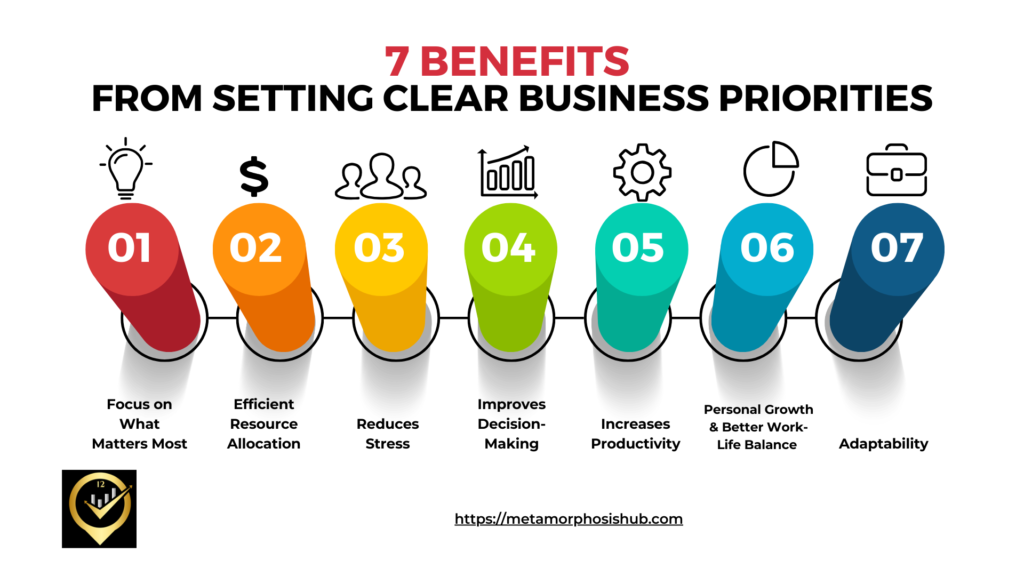Knowing how to set clear priorities is essential for time management whether you are a business owner or someone seeking to make the most of your time.
It will considerably reduce your stress levels, and is the road to achieving your goals. It is a necessary skill that can significantly impact your effectiveness and overall quality of life.
This article reviews a step-by-step approach of how to set clear priorities.
Benefits of Setting Clear Priorities
There are several benefits to be derived from setting clear priorities. They help
Focus on What Matters Most: Prioritizing helps you identify and focus on the tasks and activities that are most important and aligned with your goals, values, and objectives. It ensures that you dedicate your time and energy to activities that have the greatest impact on your life or work.
Your priorities should align with your long-term goals. By consistently working on your top priorities, you make progress toward your objectives, whether they are personal or professional.
Efficient Resource Allocation: Time is a finite resource, and prioritization allows you to allocate it wisely. By determining what needs your immediate attention and what can wait, you can make better decisions about how to spend your time and avoid wasting it on less important tasks.
Reduces Stress: When you have a clear set of priorities, you can reduce the stress and overwhelm that often come with a long to-do list. You can tackle tasks in a systematic and organized manner, knowing that you’re addressing the most critical items first.
Improves Decision-Making: Prioritization helps you make quicker and more informed decisions. You can assess the urgency and importance of tasks and make choices accordingly. This prevents you from getting stuck in indecision or being paralyzed by too many options.
Increases Productivity: Focusing on high-priority tasks ensures that you make the best use of your time. You’re less likely to waste time on trivial or non-essential activities, leading to increased productivity and efficiency.

Personal Growth and Better Work-Life Balance : Prioritization allows you to create space in your schedule for personal development, learning, and self-care. These activities often get neglected if you don’t consciously make time for them.
By setting priorities, you can strike a balance between your work and personal life. You’re less likely to overcommit to work or neglect your personal responsibilities and relationships.
Consistently managing your time based on priorities is a key ingredient for long-term success. It helps you stay on track, remain motivated, and make steady progress toward your life and career objectives.
Adaptability: Prioritization also enables you to adapt to changing circumstances and unexpected events more effectively. When something urgent arises, you can assess its importance in the context of your existing priorities and adjust your plan accordingly.
How to Set Clear Priorities – The Process
Identify Your Goals
Start by defining your short-term and long-term goals. What do you want to achieve in your business or personal life?
Your priorities should align with these goals. It is preferable that you set quarterly goals, as these can then more easily be broken down by month and week.
How to Set Clear Priorities – Make Your Goals SMART
Ensure your priorities are Specific, Measurable, Achievable, Relevant, and Time-bound (SMART). This makes them more actionable and easier to track progress.
Categorize Tasks and Responsibilities – Use the Eisenhower Matrix
Start off by breaking down your monthly tasks and responsibilities into categories. For example, you can categorize them as “urgent,” “important,” “routine,” or “non-essential” using the Eisenhower Matrix. You will do the same for weekly and daily activities later.
The Eisenhower Matrix is a useful tool for categorizing tasks based on their urgency and importance. It considers impact and consequences.
Think about the impact of each task on your goals and the consequences of not completing them. This can help you prioritize tasks that contribute most to your objectives.
- Urgent and Important: These are top priorities and should be addressed immediately.
- Important but Not Urgent: These tasks are your long-term priorities and require planning and scheduling.
- Urgent but Not Important: Try to delegate or minimize these tasks whenever possible.
- Not Urgent and Not Important: These tasks can often be eliminated or postponed.
Finally, create a ranked list of your top priorities based on their importance and alignment with your goals. Start with the most critical tasks at the top.
Strategies to Tackle the List
Learn to Say No
Sometimes, you may need to decline new tasks or opportunities that do not align with your current priorities. Saying no is essential to maintain focus.
Delegate When Possible
If you have a team or support staff, delegate tasks that do not require your direct involvement. This frees up your time for higher-priority tasks. If you do not have staff, outsource some of the work or even engage the services of a business consultant.
Allocate Time and Be Realistic
Estimate how much time each priority will require for completion. Ensure that your daily schedule reflects the time you’ve allocated to your top priorities. Don’t overload yourself with too many top priorities in a single day or week. Be realistic about what you can accomplish within the available time.
Review and Adjust Regularly
Priorities can change over time as circumstances evolve. Regularly review and adjust your list of priorities to stay aligned with your goals and current needs.
Use Time Management Tools
Consider using tools like to-do lists, calendars, and project management software to help you organize and track your priorities effectively.
Eliminate or Minimize Distractions
Minimize distractions and interruptions to stay focused on your priorities. This might involve setting specific work hours, silencing notifications, or creating a dedicated workspace.
Be Self-Disciplined
Stick to your priorities and avoid procrastination. Self-discipline is key to effectively managing your time.
As some business owners tend to find the entire process a bit overwhelming and challenging, it is wise to reach out to a consultant to provide the necessary guidance. CONTACT US TODAY to help!
Related Articles
- What are the Tell-Tale Signs of Being Overwhelmed – I alone
- Recipe for Feeling Overwhelmed all the Time – Mental Clutter
- How to Stop Being Overwhelmed – Essential Strategies
- Learn Ways to Manage Time Effectively – An Important Skill
- Time Management Procrastination – Consequences Can Be Costly
- Time Management Tools and Techniques – Choose the Best for You
Conclusion – How to Set Clear Priorities
Remember that knowing how to set clear priorities is one thing, while doing the actual work is another thing. It is an ongoing process.
Regularly reassess and adjust your priorities as your goals and circumstances will assuredly change. By following these steps and maintaining a clear focus on what truly matters, you can improve your time management and work toward your desired outcomes more effectively.

